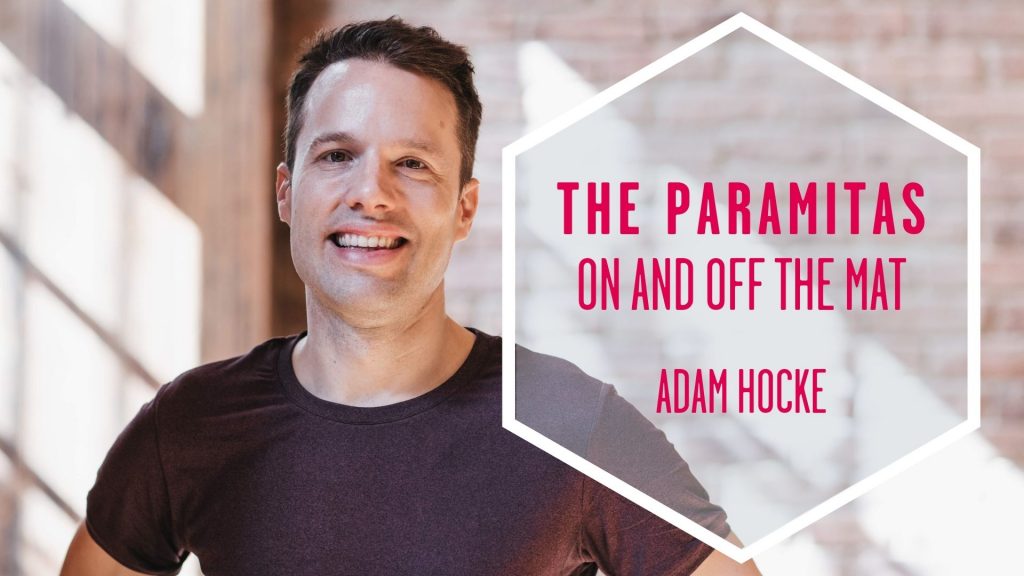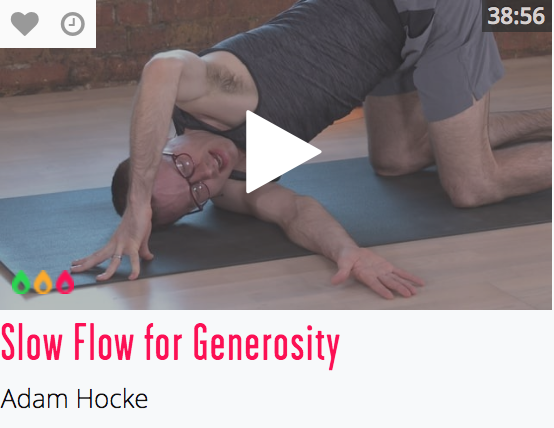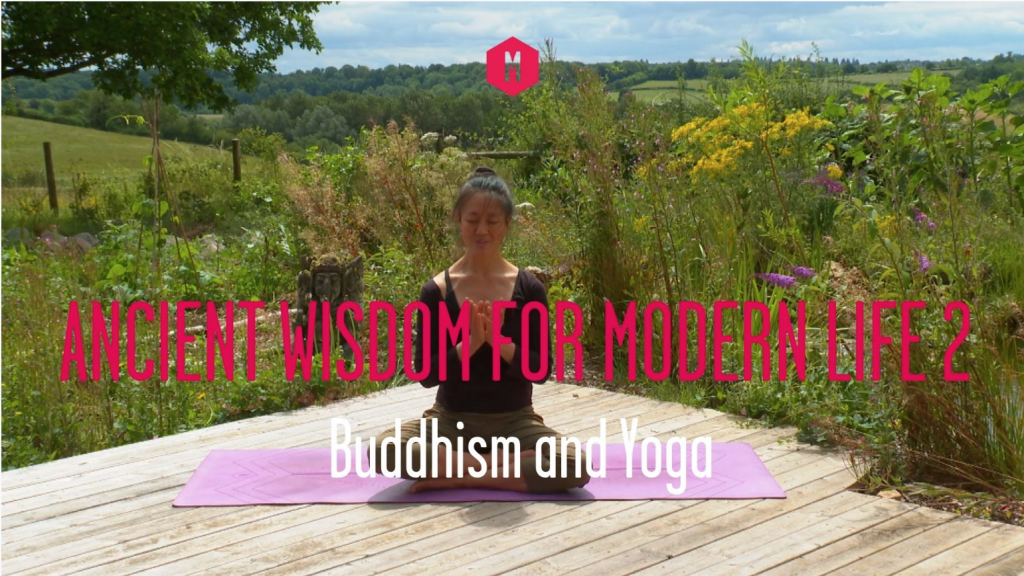
Have you been inspired by a teaching and not been sure how to enfold those teachings into your life so they feel a part of you? Adam Hocke explains why he created a series of online yoga classes to explore how we can embody qualities that we might aspire to. Adam offers an insight into the Pāramitās, and what these qualities mean to him.
There are six Pāramitās: Generosity, Discipline, Patience, Enthusiasm, Meditation, and Wisdom. Adam Hocke’s classes on the Pāramitās form part of our yoga and Buddhism course: Ancient Wisdom for Modern Life. You can read more about the relationship between yoga and Buddhism, the Pāramitās and the path of the brave yogi in the first article in this series.
Generosity
There are many ways in which we can understand generosity, and many things we can be generous with. I can be generous with my physical possessions and material wealth: I can pay for someone’s dinner; offer a room to a friend or contribute to a charity. I can also be generous with my physical body and the merits of the practice.
We know that our yoga practice makes us feel better. We might sleep better, our joints hurt less, we feel kinder. At the start of class, teachers often ask us to dedicate our practice to someone else. I used to think: “What about me? I need my practice too,” but I’ve come to see that doing this is, you end up feeling less alone. You get a greater sense of being a part of a community. You realise that you can share the sense of wellbeing you feel with others and wish them well. In fact, I think it is essential for us to ‘give away’ the merits of our practice as that is fundamental in developing a more compassionate society.
When I created this class, I was thinking of how I could replicate the feeling of generosity. The simplest way of feeling that physically, is the feeling of a hug – the act of embrace. I wanted to share many opportunities to ‘feel into’ the sensation of giving and receiving an embrace so that you can taste what it feels like to be generous with your body, with your breath, with your heart and what it feels like to ensure that the practice is of benefit to others and not just to yourself.
Practice Slow Flow for Generosity with Adam

Discipline
Discipline has different translations and connotations.We can look at all the lists we encounter within the yoga traditions, telling you what to do and what not to do as requiring discipline. In fact, all of society is based on discipline and codes of what is right and wrong. Most of the codes that we follow break down into avoiding negative actions and taking positive actions. I think, though, that it is important not just to follow these lists by rote, but rather to enquire into why they are important to us and see how we can abide by them for the benefit of others.
Discipline in yoga can mean many things, but I have focused on the intensity with which we practice.The class I put together for this series offers a process to finding a discipline and intensity of practice that is neither too rigid nor too lax. It helps you find that sweet spot of growth and change in your practice without overdoing it or chastising yourself for being ‘lazy.’ Finding this middle path is about as essentially Buddhist as you can get.
Practice Slow Flow for Discipline with Adam
Enthusiasm
Enthusiasm is super important, because if you don’t have it, there’s no way you’re getting on your mat!. This Paramita has been translated in many different ways: sometimes as exertion or diligence. For me this is the quality that helps me work on my laziness. I’m really lazy – especially in the mornings. It is a daily practice to figure out where my energy for practice is coming from. There are many traditional ways of developing enthusiasm, some as simple as morning rituals of washing your face or letting the light in. Other suggestions might include visualising a beloved teacher and let yourself be inspired by their words. It is a deeply personal process.
I wanted to create a class to inspire enthusiasm that was a bit goofy and cheerful to help us connect to a childlike sense of curiosity and play. I also tried to include a lot of humour, because a good sense of humour is vitally important in helping us not get too frustrated with laziness and fatigue. When we take practice too seriously, our perceived failures can be a major bummer and prevent us from carrying on through difficulty.
Practice Flow for Enthusiasm with Adam

Patience
I think that we all understand impatience, and that feeling of being really restless. Patience is a super useful skill to cultivate: it allows us that relationship and job-saving gap between the action and the reaction. I think we’ve all sent an email too quickly or reacted to a partner in a way that escalated the situation rather than taking a breath and paused, which could have de-escalated the situation.
I wondered about how we could embody this and came up with a class which forces us to curb our impatience by working at a much slower pace than usual and inserting pauses into our breath pattern. This practice allows me to feel what it’s like to be patient with my breath, but also forces me to feel my impatience when I want to move quicker or get through the chaturanga a little quicker because it’s hard! But in working with this slow and segmented breath I get an embodied experience of patience and impatience so I know what they are deep in my body. I learn a little bit more about myself and how to create more moments of pause and reflection in my life.
Practice Slow Flow Patience with Adam
Meditation
There are, of course, many ways of meditating. You can sit. You can walk. You can arrange flowers! Meditation is at its core about having a focus for a wandering mind and finding a bit of healing solitude in the maelstrom of contemporary life. People talk a great deal about yoga posture practice as a moving meditation, but I wanted to get a bit more specific about what that entails. For me, it’s a little bit more than just moving slowly and methodically; ‘moving meditation’ means we have to work with a method of internal and external focal points. We have to create a practice of mindfulness that is embodied and can keep up with handstands and upward-facing dogs.
In creating this class I wanted to lead us to a mental and physical state in which we are ready to meditate, but also let the whole process be a meditation. I chose to work with the external focus of our gaze and the internal focus of our deep core. I wanted to make sure we could toggle back and forth between these focal points because if we’re going to live in the world we have to strike a balance between what’s outside of us and what is deep within us. Really the focal points could be anything you choose and you can translate this process to whatever yoga practice you enjoy.
Practice Slow Flow for Meditation with Adam
Wisdom
There is ordinary wisdom and transcendent wisdom. Ordinary wisdom is having a discriminating mind that can see clearly and learn from experience. The Pāramitā of wisdom, or Prajñā, is a transcendent wisdom that is a bit more than ordinary.
This is a wisdom that helps you make the choices that decrease suffering and keeps you on your path of awakening. It is perhaps the most important Pāramitā as it holds all of the others to a higher standard, which is why I made it the first class in my ‘Brave Yogi’ series. It’s a bit of the BS detector that makes sure you aren’t on some high and mighty self-improvement quest that could ultimately make you feel and act worse. For example, you could really make yourself suffer because you think you have to be a generous person because that’s a good person; that others should see how generous you are, and you should be thanked for your actions. Your transcendent wisdom would shut that right down and remind you to not be too attached to the outcomes of your actions.
Within the context of yoga I relate it to our intention setting and remembering the reasons why we practice. In creating the class, I related this transcendent wisdom to the wisdom of the heart. In fact, I actually have you feel your beating heart and connect to your quite vulnerable human self through a series of postures that bring awareness, breath, and energy to the heartspace. Recognising our humanity and our common humanity begins the process of forming a compassionate relationship to self and society. It’s tough, which is why we practise, and why I believe it is the path of the brave yogi.
Practice for Slow Flow for Wisdom with Adam
Further practice and research
If you want to read more, Adam recommends The Heart of the Buddha’s Teaching by Thich Nhat Hahn.
It’s not too late join our Buddhism and Yoga course. Sign up now.






Leave a Reply